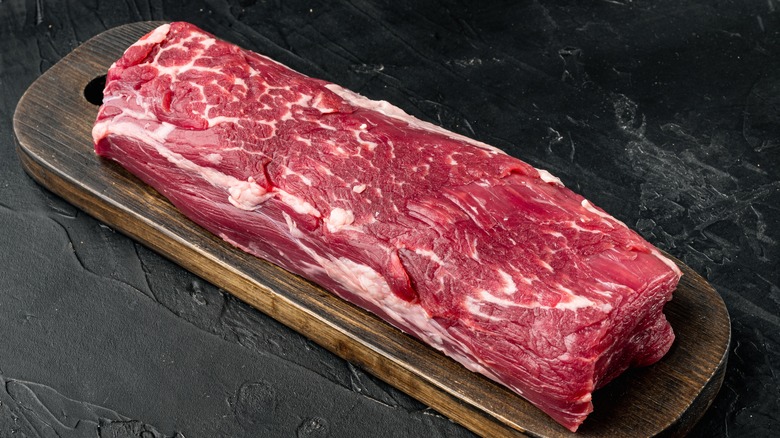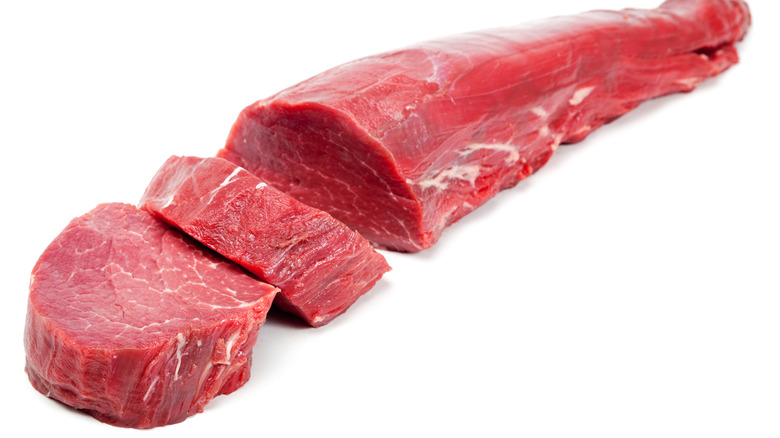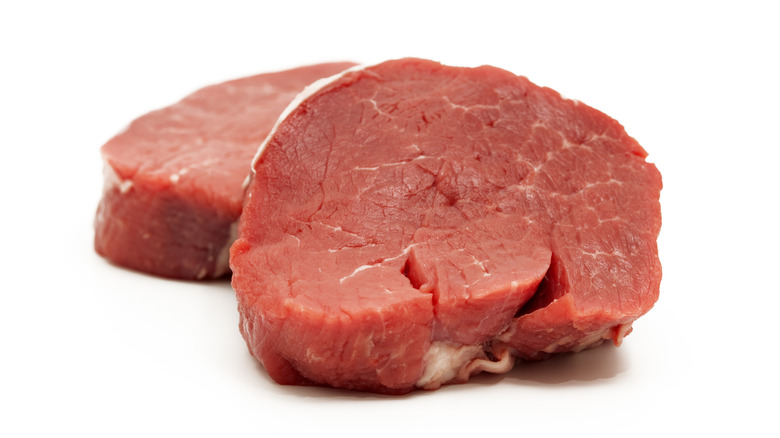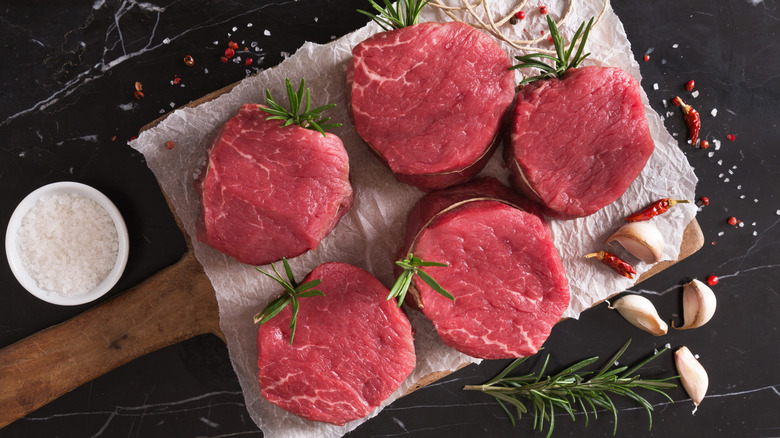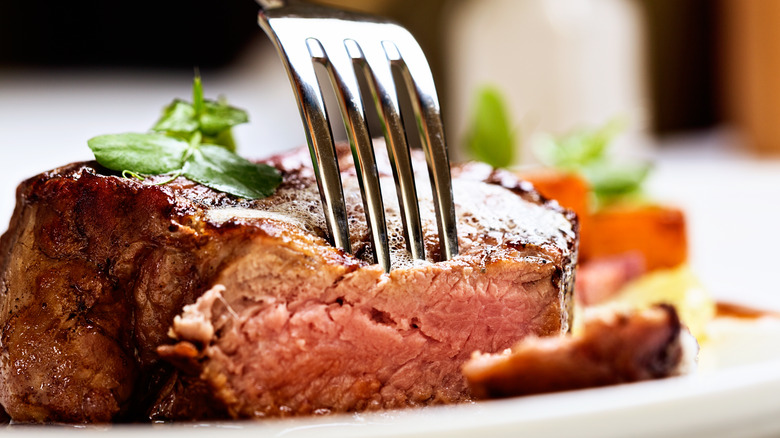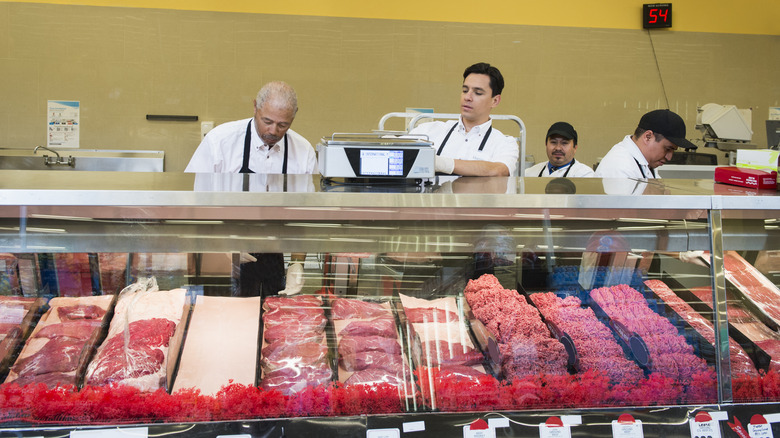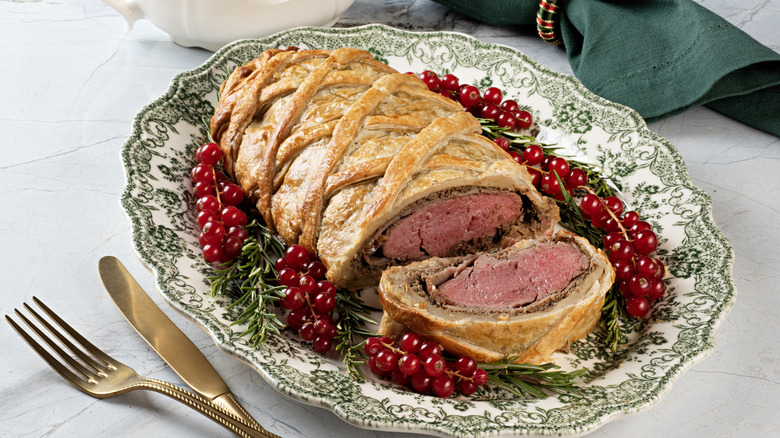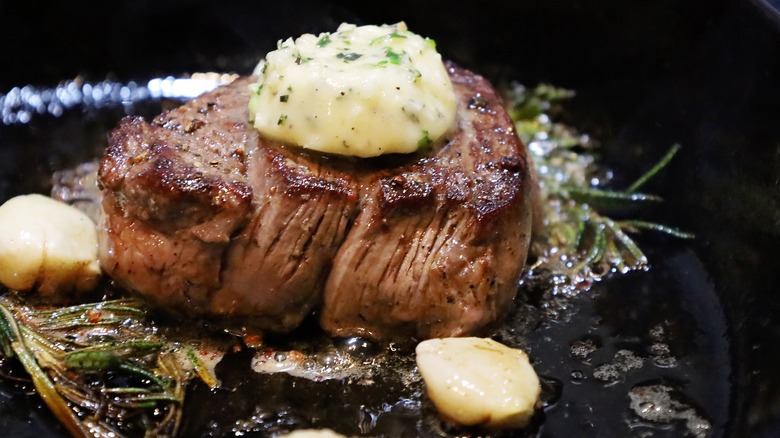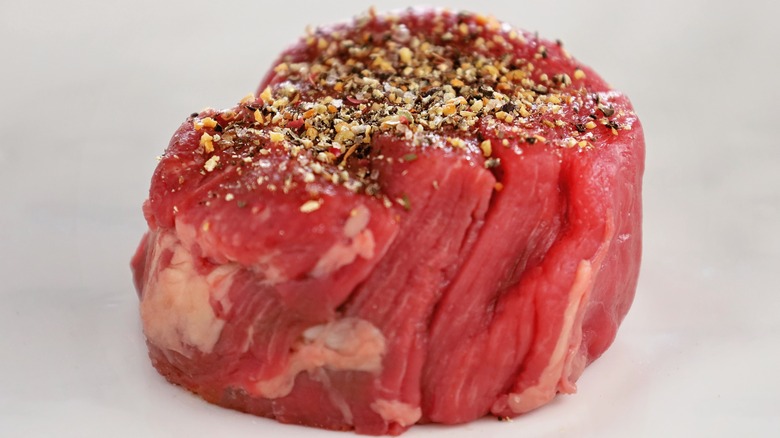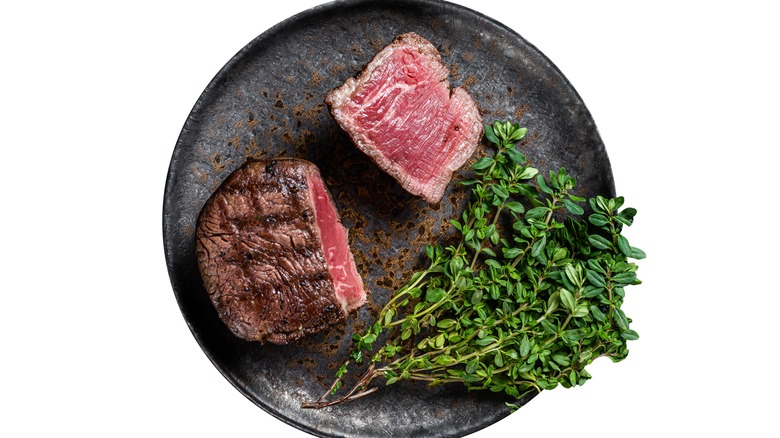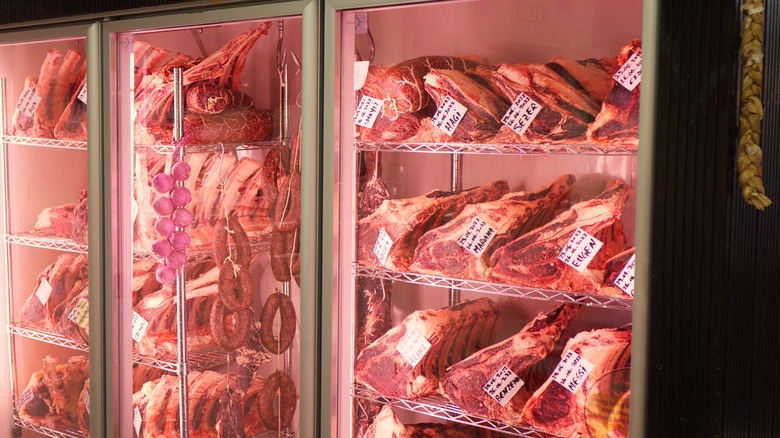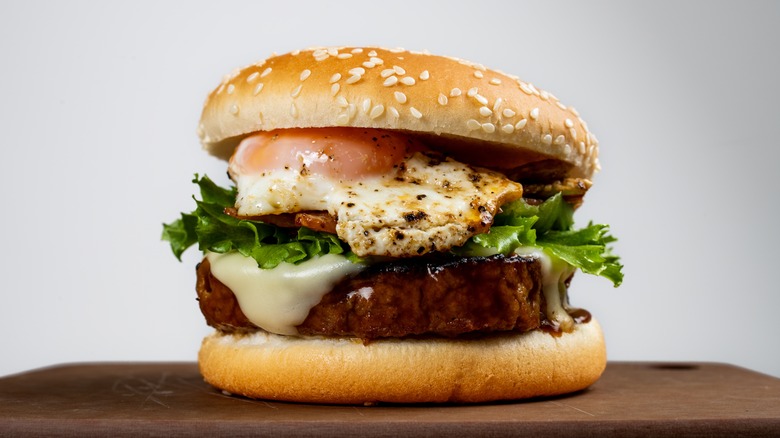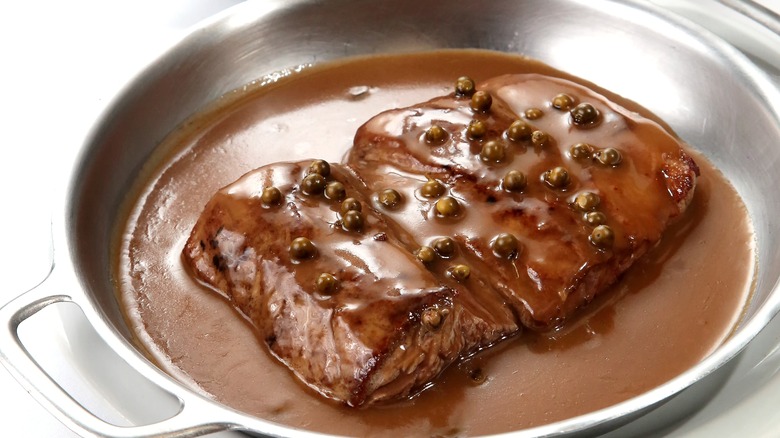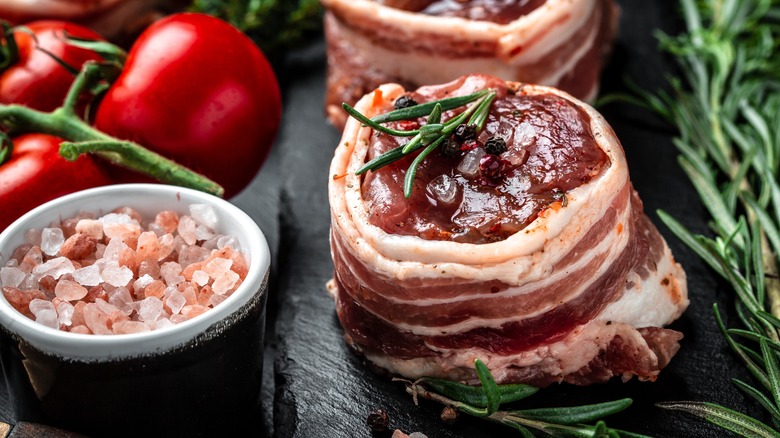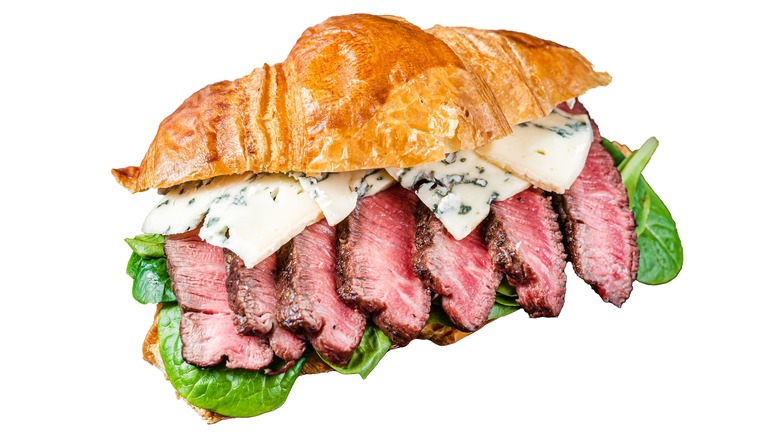Filet Mignon Vs Tenderloin: Which Cut Of Steak Should You Buy
When it comes to the most tender, buttery steakhouse staple, two cuts compete for the crown. Filet mignon and beef tenderloin are indeed similar when it comes to their texture and mild flavor, making them the perfect steaks to enjoy with all manner of classic steakhouse sauces. Both are on the pricier side of the butcher counter, and both are so luxuriously tender they can almost be cut with a fork. But do you know the differences between these two cuts of steak?
We spoke with some experts on the matter, and while far less complex than you'd think, the answer sounds a bit like a riddle at first. "All filet is tenderloin, however not all tenderloin is considered filet," explains Matthew Kreider, Executive Chef at Steak 954 in Fort Lauderdale, Florida. To clarify this assertion — and above all to understand what it means if you're cooking beef tenderloin or filet mignon at home or ordering either one at a steakhouse — here's everything you need to know about the differences between these two similar cuts of steak.
What is beef tenderloin?
Beef tenderloin is a long, narrow muscle from the loin primal, which is also home to other beloved steakhouse cuts like New York strip, T-bone, and porterhouse. Both T-bone and porterhouse actually have a bit of tenderloin on them, held together with a T-shaped bone.
Given the location of this muscle on the steer, just along the backbone and under the ribs, it should come as no surprise that it's so tender, according to Aki Suzuki, General Manager of American Cut in NYC. "Beef tenderloin is a long, cylindrical cut of meat that runs along both sides of the spine," he explains. The non-weight-bearing muscles here barely do any work while the steer is alive, which means they don't develop the same amount of connective tissue as a cut like brisket, which comes from the hard-working chest of the animal. That lack of connective tissue is what gives this cut its namesake tenderness.
What is filet mignon?
Filet mignon isn't so much a separate cut as it is a part of the tenderloin, explains Kylian Goussot, Executive Chef at Lafayette Steakhouse in Miami, Florida, describing it as "the most tender and smallest part." The tenderloin is a long cut comprised of multiple sections: The chateaubriand can be found in the middle, at the tenderloin's widest part, while a narrow strip of meat known as the chain sits along the tenderloin; this part is best cut into small pieces and stir-fried.
Only the thinner, tapered part at the front end can truly be called filet mignon. According to Aki Suzuki, filet mignon is "typically cut into individual steaks," the narrowest of which is often called the tournedos. Don't be fooled by cuts masquerading as filet mignon. While any cut of beef without a bone could technically be called a filet, you won't get the buttery texture of filet mignon anywhere else on the steer.
Filet mignon is smaller than beef tenderloin
Seeing as filet mignon is simply a part of the beef tenderloin, it should come as no surprise that it's smaller. A whole, untrimmed and unpeeled tenderloin typically weighs between 6 to 7 pounds, which includes about 1 ¼ pounds of fat and silverskin and 2 pounds of chain meat. The trimmed tenderloin proper usually weighs only about 3 pounds, depending on the size of the steer. It's no surprise, given how much of this total weight gets lost, that Costco's whole, unpeeled beef tenderloin is such an incredible bargain, going for around $17 per pound depending on location as of September 2024.
Of the tenderloin, the filet mignon is a relative fraction. A filet mignon typically weighs between 5 and 6 ounces,, and you can expect to get a total of 6 to 10 pounds of it per steer. Compared to the 12 to 14 pounds of tenderloin, that's quite a bit less filet overall.
Filet mignon is more tender than tenderloin
Both filet mignon and beef tenderloin are incredibly tender, as the name of the latter suggests. However, Aki Suzuki explains, "filet mignon, being the smaller end cut of the tenderloin, is often even more tender." Matthew Kreider agrees and says, "The filet will have just a slightly softer texture as it 'works' the least in the muscle. This lack of use is what makes it so tender to eat."
Unfortunately, taste and texture are often inversely related when it comes to beef. A more flavorful cut of beef, like brisket or oxtail, is likely to be tougher, whereas tender cuts like filet mignon and tenderloin tend to be subtler. "They are both mild in flavor compared to other cuts like ribeye or strip steak," says Suzuki of these two cuts. And this holds even more true for filet mignon, which he notes, "might have a slightly milder flavor due to its smaller size and finer muscle grain."
Filet mignon can be more expensive than beef tenderloin
Filet mignon's various characteristics make it unsurprising that it's also pricier. "Filet mignon is generally more expensive than beef tenderloin as a whole because it is a smaller, more tender, and more prized cut," explains Kylian Goussot. Matthew Kreider agrees. "I find filet mignon will typically run a little more on the pricey side compared to tenderloin," he says. "People tend to see it as a much more 'fancy' and desired cut."
But this isn't always the case. At the esteemed butcher shop Lobel's of New York, filet mignon and tournedos both retail for $199.95 for a 32-ounce package, or just about $100 per pound. A whole 20-ounce tenderloin, meanwhile, costs $139.95, which is actually more expensive, at around $112 per pound. And filet tails, cut from the thin end of the tenderloin, are priced at a mere $54.95 for a two-pound package, a steal at just over $27 per pound.
Beef tenderloin can be treated like a roast
When sold whole, beef tenderloin is perfect for classic preparations, like oven-roasted beef tenderloin or pastry-wrapped beef Wellington, which has an added layer of mushroom duxelles between the juicy beef and the crisp, buttery dough. Either option makes for an impressive dish for a crowd. "If the tenderloin is whole, I would cook it as a roast," says Matthew Kreider. "It's nice and easy to carve for groups of people."
"For a dinner party or family gathering, roasting a whole tenderloin is fantastic," echoes Aki Suzuki. As for how to go about this, he has a few ideas. He starts by searing the tenderloin well on all sides, which brings out a lovely caramelized flavor thanks to the powers of the Maillard reaction. He then crusts the tenderloin in herbs like rosemary, thyme, and garlic, before roasting it in the oven. The result, he says, is a flavorful outer layer with a tender, juicy interior that's easy to slice and serve as is.
Beef tenderloin and filet mignon can both be treated like a steak
A whole roast isn't the only way you can prepare a beef tenderloin. Much like filet mignon, beef tenderloin can also be cut into steaks, which Aki Suzuki suggests for the perfect intimate meal. He begins by pan-searing the filet mignon or beef tenderloin steaks in a hot cast-iron skillet with butter, garlic, and herbs. Then, he finishes the steaks in the oven until they reach the desired doneness. "This technique provides a nice crust while maintaining tenderness," Suzuki describes.
Kylian Goussot likes to prepare either cut by pan-searing the steaks at a very high temperature to form "a delicious golden crust." Next, he says, "I finish it with thyme, garlic, and butter until it reaches the desired internal temperature."
Matthew Kreider goes so far as to say he favors the individual steaks over a whole tenderloin, noting that he prefers the "nice texture of a pan sear or grill" over that of a whole roast. Indeed, the direct contact with the ripping hot heat of a cast iron pan achieves a crispy exterior that the indirect heat of the oven can rarely match. The result is a beautiful textural contrast between the crust and the tender meat within.
Both filet mignon and beef tenderloin are very lean
Both beef tenderloin and filet mignon are relatively low in connective tissue and fat compared to other steaks. In fact, tenderloin is one of the leanest cuts of beef out there, with just 7 grams of fat per 100 gram serving. Compared to richer cuts like ribeye, with a whopping 19 grams of fat per 100 grams of meat, tenderloin is certainly a lower-fat option.
But while this might seem like an advantage from a health perspective, a very lean cut has a few downsides. Lean cuts of meat are less forgiving of overcooking than fattier cuts, which means that just a moment's distraction can transform these steaks into expensive hockey pucks. And what's more, marbling — which refers to the flecks of intramuscular fat you'll see on fattier cuts like ribeye — adds loads of flavor and juiciness to meat. Both tenderloin and filet mignon lack these attributes, leading many chefs and home cooks to overcompensate with rich sauces. While delicious, these accompaniments increase the overall fat content of the steaks significantly, offsetting any health benefits of choosing a leaner cut of steak.
Both filet mignon and beef tenderloin are best cooked no further than medium-rare
Given the leanness of tenderloin and filet mignon, both steaks are best cooked no further than medium-rare, according to Aki Suzuki. "This keeps the meat tender and juicy without overcooking," he says. Matthew Kreider agrees. "I would never cook past medium rare," he says. "There is not a lot of fat to protect the steak and it loses its juices pretty quickly. The texture changes quite dramatically once you go past medium."
For the perfect medium-rare steak, Suzuki recommends cooking it until it hits an internal temperature of 130 to 135 degrees Fahrenheit. Kreider thinks the easiest way to get there is by searing in a cast iron pan. "This gets a really nice crust and crispy texture that other cooking methods will not, while not overcooking the steak," he says. And as with all steaks, don't forget to rest the meat before serving, so the juices can redistribute and the interior of the steak remains moist.
Neither filet mignon nor beef tenderloin are much improved by dry-aging
Dry-aging beef is all the rage these days, as a beloved technique for imparting a funkier, beefier flavor to your favorite cuts of steak. But filet mignon is not necessarily set to its best advantage when dry-aged. One major goal of dry aging is to tenderize tougher cuts of meat; to tenderize an already extremely tender cut like tenderloin can result in a steak with an unappetizingly mushy texture.
And that's not all. As Katie Flannery of Flannery Beef explains, since dry-aging essentially involves allowing the outer layers of the cut of beef to succumb to controlled rotting, it contributes to phenomenal loss with regard to the filet. Unlike other cuts like the short loin, a tenderloin has no protective covering, meaning the excess that is trimmed away is fairly wasteful. Any flavor development, she says, isn't worth doubling the cost of this already expensive cut.
Neither beef tenderloin nor filet mignon make a good hamburger
Grinding filet mignon or beef tenderloin for a hamburger is criminal behavior in the world of butchery. These cuts, known for their tenderness, lose exactly what makes them so beloved the moment they go through the grinder. But it's not just the expense that makes filet mignon and beef tenderloin such bad burger bases.
The best burger meat typically boasts a meat-to-fat ratio of 80-20 or even 70-30. Lean beef tenderloin and filet mignon, with just around 7 grams of fat per 100 grams, have a ratio of 93 to 7. For a great burger, your best bet is to seek out fattier, inexpensive cuts like chuck, which naturally boasts an 80-20 meat-to-fat ratio. This tougher, richly flavored cut actually benefits from being ground, which helps to break apart some of that chewy connective tissue and turn it into a tender, delicious patty.
Both beef tenderloin and filet mignon are great with sauces
The lack of fat in tenderloin and filet mignon also means that both are particularly tasty with sauces, which add much-needed flavor and fat. "Both of these steaks are what I would call sauce sponges!" says Matthew Kreider. As for which sauce to choose, the possibilities are endless. Aki Suzuki notes that a sauce can be as simple as a homemade compound butter, seasoned with garlic, herbs, or spices. Make logs of compound butter in advance and freeze them in tightly wrapped logs, so that you always have some to use to bring out the best in your beef.
Meanwhile, a French bordelaise made with red wine, bone marrow, and butter is certainly luxurious, and a zingy chimichurri from Argentina adds brightness and zip. A horseradish-infused creme fraiche sauce is a snap to pull together, if you want something quick and easy, though a more complex pan sauce like au poivre is certainly impressive — and it helps that filet mignon is the most traditional option for French steak au poivre recipes.
Filet mignon is delicious wrapped in bacon
One other way that some butchers, chefs, and home cooks impart even more flavor and fat to filet mignon is by wrapping the steaks in bacon. This technique doesn't just naturally baste the filet mignon in tasty, smoky fat, but it can also serve to hold together the end, which occasionally come apart into two pieces.
To master this technique, it's important to keep a few things in mind. Since filet mignon can overcook so quickly — even with the protective coating of bacon — it's essential to sear the steaks quickly in a pan and finish them in the oven, where the indirect heat will ensure the bacon and steak are cooked to perfection. Resist the urge to use thick-cut bacon here, as it will not cook through until the steak is far past the desired medium-rare. If you prefer your steak on the rarer side, it may even be worth it to par-cook the bacon slightly, either in the oven or the microwave, before cooling it and affixing it to the filet.
While you can purchase filet mignon already wrapped or "barded" in bacon, this tends to be far more expensive than just doing it yourself. When attaching the bacon to the filet, stretch it slightly so that it's taut, helping the steak hold its shape and ensuring it doesn't loosen when the steak invariably shrinks during the cooking process.
Leftover filet mignon and beef tenderloin are best enjoyed cold
It's rare to end up with leftover filet mignon or beef tenderloin. After all, these lean, expensive cuts are typically served in portions that are just right for the individual diner, and unlike richer ribeye, it's easy to finish off that last, lingering bite. But should you end up with leftovers, resist the urge to try to reheat them. While it's possible to use a low-and-slow method to heat the steak back up, the risks of overcooking and ending up with dry steak just aren't worth it.
Instead, allow the steak to temper to room temperature and enjoy it cold. Thinly sliced leftover beef tenderloin is delicious on a sandwich or slider, preferably smeared with a bit of creamy horseradish sauce. Consider using a richer roll like a buttery croissant and adding some blue cheese to add even more flavor to the finished dish. The leftover beef can also be sliced and served on top of a Caesar salad or Cobb salad in place of grilled chicken to lend special occasion flair to these dishes.
